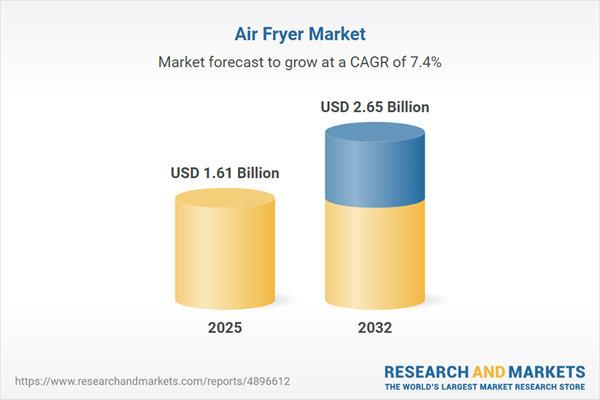Speak directly to the analyst to clarify any post sales queries you may have.
The air fryer market is evolving rapidly, characterized by technology-driven innovation, versatile applications, and heightened consumer focus on health and convenience. Senior decision-makers need actionable insights to identify emerging opportunities, mitigate risks, and stay ahead in a landscape influenced by regulatory, behavioral, and operational shifts.
Market Snapshot: Current State of the Air Fryer Market
The air fryer market grew from USD 1.50 billion in 2024 to USD 1.61 billion in 2025, and it is forecast to reach USD 2.65 billion by 2032 at a compound annual growth rate (CAGR) of 7.35%. Market expansion continues to be supported by advancements in high-speed convection technology, growing health awareness, and increased adoption across both residential and commercial sectors. Innovation in digital controls and smart connectivity is further accelerating adoption among diverse consumer groups, while sustainability and regulatory compliance play a greater role in product development and go-to-market approaches.
Scope & Segmentation: Air Fryer Market
- Type: Basket-style, countertop, paddle, toaster-oven air fryers
- Mode of Operation: Digital, manual
- Capacity: Large, medium, small
- Sales Channel: Offline retailers (department, specialty, supermarkets); online (company websites, e-commerce platforms)
- End User: Commercial (cafeterias, hotels, restaurants, school canteens); residential
- Regional Coverage: Americas (United States, Canada, Mexico, Brazil, Argentina, Chile, Colombia, Peru); Europe, Middle East & Africa (United Kingdom, Germany, France, Russia, Italy, Spain, Netherlands, Sweden, Poland, Switzerland, United Arab Emirates, Saudi Arabia, Qatar, Turkey, Israel, South Africa, Nigeria, Egypt, Kenya); Asia-Pacific (China, India, Japan, Australia, South Korea, Indonesia, Thailand, Malaysia, Singapore, Taiwan)
- Technologies: High-speed convection, precision temperature controls, sensor integration, IoT connectivity, sustainable materials adoption
- Key Players: Companies such as Philips, BLACK+DECKER, Cosori, Breville, De'Longhi, Haier, Xiaomi, Midea, Electrolux, SharkNinja, and other regional specialists
Key Takeaways for Senior Decision-Makers
- Industry stakeholders must navigate a landscape reshaped by dynamic consumer behavior and increasing regulatory complexity, both impacting design, sourcing, and marketing.
- Multifunctionality and digital integration have redefined product positioning, with smart features and remote operations differentiating leading portfolios from traditional models.
- Direct-to-consumer and omnichannel sales strategies are critical to meeting evolving buyer preferences for convenience, choice, and tailored experiences across various geographies.
- Premium and professional-grade air fryers remain resilient segments, especially in commercial kitchens and among discerning consumer segments less sensitive to price volatility.
- Sustainability imperatives—from material innovation to energy efficiency and product end-of-life strategies—are influencing procurement, manufacturing, and customer communication.
- Collaborative ecosystems spanning appliance manufacturers, software partners, and retailers are accelerating innovation and deepening recurring customer engagement.
Tariff Impact on the US Air Fryer Market
Recent tariffs on imported components and finished air fryer units have reshaped the US supply chain, increasing raw material costs and prompting manufacturers to explore alternative sourcing. These cost pressures have led global brands to accelerate nearshoring, while smaller firms face consolidation. Differentiated customer segments, such as premium buyers, display resilience, whereas price-sensitive groups may defer purchases. Strategic cost containment and tailored features are now central to navigating this volatility and maintaining competitive positioning.
Robust Methodology & Data Sources
The report’s findings stem from a rigorous multi-source approach, integrating primary interviews with senior industry insiders, supply chain specialists, and key distributors. Secondary insights from technical white papers, regulatory filings, and proprietary pricing databases underpin scenario analysis and data triangulation. Peer review and cross-source validation ensure the integrity and reliability of every conclusion.
Why This Report Matters: Strategic Value for Decision-Makers
- Enables informed strategy by decoding evolving technological and consumer trends that redefine market opportunities and risks.
- Empowers leaders to optimize supply chains, align portfolios with shifting regulations, and strengthen competitive advantages through actionable segmentation intelligence.
- Supports investment planning and product development with granular, region-specific insights across all major segments and geographies.
Conclusion
The air fryer market’s growth trajectory is shaped by innovation, regulatory shifts, and nuanced consumer demands. Decision-makers equipped with clearly segmented, actionable insights are best positioned to drive success in this evolving ecosystem.
Additional Product Information:
- Purchase of this report includes 1 year online access with quarterly updates.
- This report can be updated on request. Please contact our Customer Experience team using the Ask a Question widget on our website.
Table of Contents
3. Executive Summary
4. Market Overview
7. Cumulative Impact of Artificial Intelligence 2025
Companies Mentioned
The companies profiled in this Air Fryer market report include:- American Micronic Instruments Pvt Ltd
- Bajaj Electricals Ltd.
- BLACK+DECKER Inc.
- Breville Pty Ltd.
- Chefman by RJ Brands, LLC.
- Cosori by Vesync Co., Ltd
- Cuisinart by Conair LLC
- Dash, LLC
- De’ Longhi Group
- Electrolux Group
- GoWISE USA by Ming's Mark Inc.
- Groupe SEB
- Haier Smart Home Co., LTD
- Hamilton Beach Brands Holding Company
- Kalorik Electronics Technology (Xiamen) Co.,Ltd
- KENT RO Systems Limited
- Midea Group Co., Ltd.
- Newell Brands Inc.
- NuWave, LLC
- Panasonic Holdings Corporation
- Russell Hobbs, Inc. by SPECTRUM BRANDS HOLDINGS, INC.
- SECURA MONDE INTERNATIONAL LIMITED
- SharkNinja, Inc.
- Taurus Group
- Tristar Group
- Typhur Inc.
- Versuni (Philips Domestic Appliances)
- Xiaomi Corporation
Table Information
| Report Attribute | Details |
|---|---|
| No. of Pages | 195 |
| Published | November 2025 |
| Forecast Period | 2025 - 2032 |
| Estimated Market Value ( USD | $ 1.61 Billion |
| Forecasted Market Value ( USD | $ 2.65 Billion |
| Compound Annual Growth Rate | 7.3% |
| Regions Covered | Global |
| No. of Companies Mentioned | 29 |









